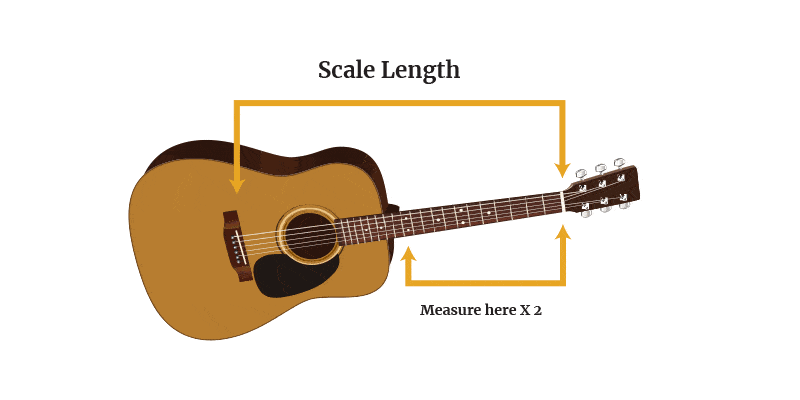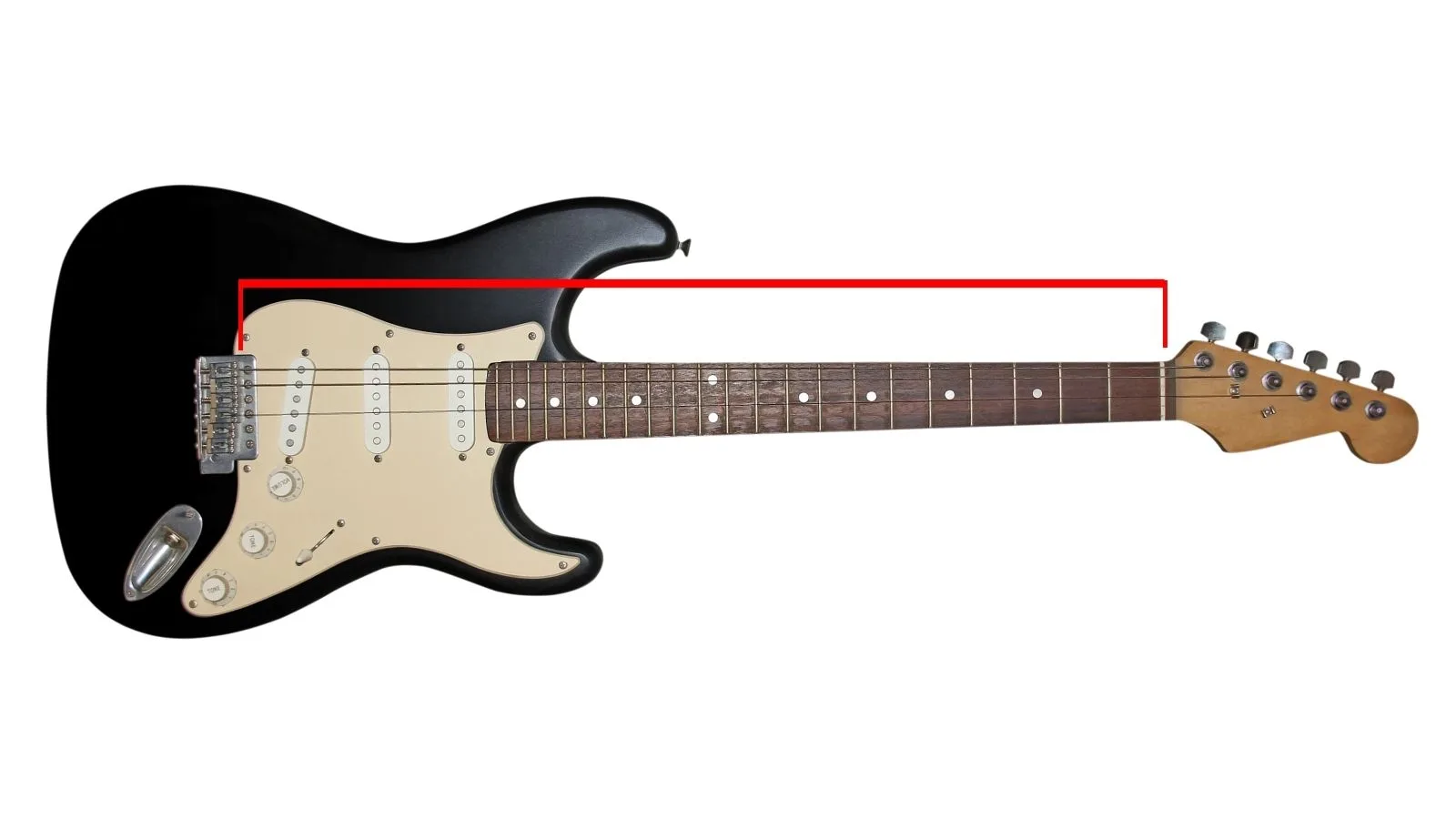Have you ever wondered how the length of your guitar neck affects the sound you produce? Are you a beginner guitarist looking to understand the concept of scale length and how it can impact your playing? Well, look no further because in this article, I will guide you through everything you need to know about measuring guitar scale length.
As a professional guitarist with years of experience and a passion for understanding the technical aspects of my craft, I have delved deep into the world of scale length. And now, I want to share that knowledge with you! Whether you’re just starting out or have been playing for some time, knowing how to measure guitar scale length is crucial in finding the best fit for your musical style and preferences.
So let’s dive into this comprehensive guide where we’ll explore what exactly scale length is, why it matters, different ways to measure it accurately, and how it can affect your playing. By the end of this article, not only will you be able to confidently measure your own guitar’s scale length but also understand its importance in mastering this beautiful instrument. So grab your guitar and get ready to become an expert on all things related to guitar scale lengths!
So, how to measure guitar scale length?
Learning to play the guitar is an exciting journey, and one of the first things you’ll come across is understanding scale length. But what exactly does this term mean and why is it important for beginners to know?
In simple terms, scale length refers to the distance between the nut (where the strings begin) and the bridge (where they end) on a guitar. This measurement plays a crucial role in determining how your instrument sounds and feels when playing.
A shorter scale length means that there will be less tension on the strings, making them easier to press down. This can be helpful for beginners who may struggle with finger strength or experience discomfort while playing. On the other hand, a longer scale length creates more tension on the strings, resulting in a brighter sound and potentially requiring more effort from your fingers.
As a beginner, it’s important to understand how different scales lengths can affect your playing style and preferences. Some people may find it easier to learn on a shorter scale guitar while others may prefer longer scales for their specific genre of music.
But don’t worry too much about finding the perfect scale length right away – as you continue learning and developing your skills, you’ll naturally gravitate towards certain instruments that feel comfortable for you.
It’s also worth noting that electric guitars typically have longer scale lengths compared to acoustic guitars. This is because electric guitars use thinner strings which require more tension to produce sound.
Ultimately, mastering guitar scale length comes down to personal preference and experimentation. As long as you are aware of its importance in creating different sounds and styles of play, you’ll be well-equipped to choose an instrument that suits your needs as a beginner guitarist. So keep strumming those chords and exploring different scales – before long, you’ll find yourself confidently navigating through any song with ease!
Understanding the Concept of Guitar Scale Length
When you pick up a guitar, have you ever wondered why some guitars feel different from others? One important factor is the scale length. This term refers to the distance between the nut (the piece at the top of the neck) and the bridge (where the strings are anchored). Generally, guitars have scale lengths that range anywhere from 24.75 inches to 25.5 inches. A shorter scale length often makes it easier to press down on frets, offering a softer touch for players with smaller hands or those who enjoy bending notes smoothly. In contrast, longer scales can produce a brighter tone and more tension in each string, which appeals to many rock and blues musicians.
Beyond just comfort while playing, scale length affects how your guitar sings! Different lengths contribute distinctively to your instrument’s sound quality and overall character. For example, guitars with shorter scales might offer warmer tones that sound rich and rounded—perfect for jazz or folk music. On the flip side, longer-scale guitars often deliver clearer highs and pronounced lows; they excel in genres like metal where precision is key. Understanding this concept can help you choose an instrument that feels right in your hands while matching your personal style!

Read also: 27 inch scale guitar
Identifying the Impact of Scale Length on Your Playing Style
When you pick up a guitar, the length of its scale can significantly shape how you sound and play. Scale length is the distance from the nut to the bridge, and it influences everything from string tension to tonal quality. For instance, a shorter scale length—like that found on many Gibson guitars—offers softer string tension, making it easier for your fingers to press down notes. This is especially great for beginners or those who enjoy bending strings and playing with ease. Conversely, longer scales are typically associated with Fender guitars and provide tighter string tension which often results in brighter tones and more sustain. Musicians often find that their preferred style emerges naturally through these variations.
Moreover, understanding how scale length affects your playing style helps expand creativity too! If you’re exploring genres like blues or jazz where smooth bends are crucial, you might lean towards shorter scales for their comfort and expressiveness. On the other hand, if rock or metal fuels your passion, long-scale guitars could give that aggressive punch needed for powerful riffs. The difference in feel can be remarkable; you’ll notice subtle shifts in how melodies flow under your fingers as you embrace one scale over another.
Ultimately, experimenting with different instruments not only enhances skill but also deepens appreciation for what each unique design offers!
Applying Correct Methods to Measure Guitar Scale Length
Measuring the scale length of a guitar is an essential step for musicians seeking to understand the instrument’s playability. The scale length refers to the distance from the nut (the small piece at the end of the neck) to the saddle (where strings rest on the bridge). To obtain an accurate measurement, start by finding a reliable ruler or tape measure and ensure it’s in inches or millimeters, depending on your preference. Position one end of your measuring tool at the nut and stretch it straight down to where it meets the saddle. It’s crucial that you do this without any curves; even a slight angle can lead to inaccuracies.
For more precise results, consider using these tips:
- Check String Action: Make sure there’s no excessive height between your strings and fretboard.
- Tune Your Guitar: Ensure it’s properly tuned before measuring since changes in tension can slightly alter distances.
- Avoid Distractions: Find a quiet place so you can focus entirely on getting that exact measurement.
By applying these methods correctly, you’ll gain valuable insights into how your guitar behaves and how best to adjust it for optimal sound and comfort!
How Different Factors Influence the Measurement of Scale Length
When we talk about measuring scale length, several factors can come into play that significantly influence the results. One crucial element is the material being measured. For instance, if you’re dealing with a stretchy fabric versus a stiff metal ruler, the way each expands or contracts in temperature will affect accuracy. This means that two objects of the same nominal size could yield different measurements simply due to their material properties. Additionally, environmental conditions, like humidity and temperature fluctuations, can cause materials to change slightly in size. These alterations may seem minor but can lead to notable differences over larger distances.
Another important factor involves the technique used during measurement itself. For example, how one holds a measuring tool—whether firmly against an object or at an angle—can change outcomes drastically. The precision of instruments also plays a role; using a high-quality caliper might give you more accurate readings than relying on an everyday tape measure with worn markings. Finally, human error cannot be overlooked; even experienced individuals might misread scales under specific lighting conditions or distractions nearby. All these elements combine to create an intricate dance where precision depends on many intertwined variables rather than merely grabbing a ruler and taking a quick measurement.
You may also like: Which guitar has the best sound quality
Making Adjustments in Your Technique Based on Guitar’s Scale Length
When playing the guitar, understanding how scale length influences your technique can make a world of difference. Scale length refers to the distance between the nut (where the strings rest at the headstock) and the bridge (where they are anchored on the body). Different guitars, like a Fender Stratocaster or Gibson Les Paul, have unique scale lengths that affect string tension and playability. If you find yourself playing a shorter scale guitar, such as one with 24 inches, you’ll notice that bending strings is easier due to less tension. This allows for more expressive soloing without straining your fingers.
On longer-scale guitars, typically around 25.5 inches or longer, you may need to adjust your fretting technique slightly. The increased tension means each note might require more strength when bending or pressing down on strings. Musicians often adapt by using lighter gauge strings or altering their finger positioning for smoother transitions across frets. Additionally, practicing scales in different positions helps develop muscle memory tailored to each instrument’s characteristics.
By recognizing these nuances in scale length and adjusting accordingly—whether it’s modifying how hard you press down on strings or changing up your pick attack—you’ll enhance both comfort and sound quality in your playing journey!
Conclusion: Mastering Guitar Through Understanding Its Inner Workings
To truly master the guitar, one must delve deep into its inner workings, going beyond just strumming chords and playing notes. Understanding how a guitar produces sound can greatly enhance your playing experience. The instrument relies on vibrations from the strings that resonate through the body of the guitar. When you pluck a string, it vibrates at specific frequencies, which creates different pitches depending on tension and thickness. This is where knowledge about string types comes in handy; lighter strings are easier to bend for solos while heavier ones offer more depth for rhythm.
Moreover, learning about different parts of the guitar—such as the neck, fretboard, and pickups—can enrich your skills even further. The fretboard allows you to create melodies by pressing down on various frets while moving up and down the neck adds versatility to your repertoire. Understanding pickups helps clarify how electric guitars amplify sound: single-coil pickups provide clarity but can be noisy; humbuckers deliver warmth without that annoying buzz. By mastering these elements and their interactions with each other, you’re not just becoming a player; you’re evolving into a versatile musician who knows how to coax beautiful sounds from this remarkable instrument.

